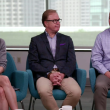by Liz Ann Sonders, Chief Investment Strategist, & Kevin Gordon, Charles Schwab & Company Ltd.
After falling into its own recession last year, the housing market has started to turn decisively higher; but a sustained recovery might not be the strongest elixir for the economy.
Given this report focuses on the housing market, we'll opine on the other indicators in the future; but key to watch for are signs of life in confidence metrics and the manufacturing sector. A sustained turn higher would confirm the transition from rolling recessions into rolling recoveries, but it's too soon to make that determination.
Housing rolling into recovery?

Source: Charles Schwab, Bloomberg, The Conference Board.
CEO Confidence Index as of 2Q2023; National Association of Homebuilder (NAHB) Housing Market Index as of 6/19/2023. S&P 500® as of 6/23/2023; University of Michigan Consumer Sentiment as of 6/16/2023; and Institute for Supply Management (ISM) Manufacturing and New Orders as of 5/31/2023. NAHB indexed to 100 at November 2020; ISM Manufacturing New Orders indexed to 100 at December 2020; ISM Manufacturing indexed to 100 at March 2021; UMich Consumer Sentiment indexed to 100 at April 2021; CEO Confidence Index indexed to 100 at 2Q2021; S&P 500 indexed to 100 at January 2022. Red circles indicate peak in respective series. Percentages in callout boxes indicate maximum drawdowns from peak in activity. Past performance is no guarantee of future results.
Given homebuilder sentiment is one of the most leading economic indicators, one would expect a material turn higher in home sales to follow the recent return of optimism. That has happened to some extent, but not evenly. As you can see in the chart below, sales for both existing and new homes have bounced off their recent troughs, but the strength has been more pronounced in the new home market (caveat: this report was published before the release for May new home sales data). Not only did new home sales find their recent trough sooner (last July), but they're up by 26% (through April) since then. Existing home sales are up by a weaker 7% (through May) since their trough in January.
New home sales recovering faster

Source: Charles Schwab, Bloomberg, as of 5/31/2023.
With demand for homes still relatively strong, some buyers in the existing market have been pushed into the new market. As many homebuilders have been offering incentives like premium finishes, mortgage rate buydowns, and other concessions, the process has looked relatively more attractive for buyers. Plus, high mortgage rates are not yet scarring the process, given all-cash deals are still around.
You can see in the chart below that there is a stark difference in monthly supply metrics As of May, existing monthly supply stood at three—meaning it would take only three months to sell every home currently on the market at the current sales pace. That has kept buyers in the existing market in an increasingly tough position, forcing them to explore new construction.
Better recovery in new supply

Source: Charles Schwab, Bloomberg, as of 5/31/2023.
Prices (finally) declining

Source: Charles Schwab, Bloomberg, as of 5/31/2023.
Affordability in a tough spot

Source: Charles Schwab, Bloomberg, as of 5/31/2023. See disclosures for parameters used.
Hopeful signs of disinflation
The rub is that we can't glean a ton from that burst in activity. Some of the strongest jumps throughout history have been during both recessions and expansions (notably, the largest gain of 29% was in the midst of the recession that started in 1981). Previous spikes of similar magnitude were generally followed by at least some reversal in the subsequent few months, so keep that in mind near-term.
(Housing) start your engines

Source: Charles Schwab, Bloomberg, as of 5/31/2023.
Multi-year streak for multi-family

Source: Charles Schwab, Bloomberg, as of 5/31/2023.
Rental inflation set to turn?

Source: Charles Schwab, Bloomberg. CPI data as of 5/31/2023; S&P data as of 3/31/2023.
In sum
We do not expect a significant decline in mortgage rates, even if the Federal Reserve is getting close to ending its rate-hiking cycle. Even if mortgage rates begin to decline and housing continues to improve, it doesn't keep a formal recession at bay. Case in point: 2001, when (like at present) non-residential (business) investment was where weakness was concentrated. Perhaps the brightest spot will be the much-needed aid to still-high inflation, given the home-price decline underway. We'll take disinflationary forces anywhere we can get them.















